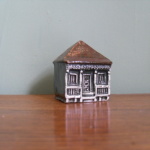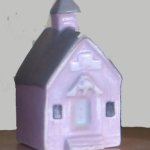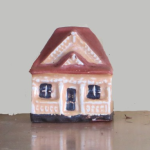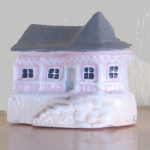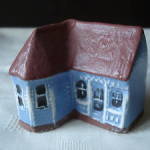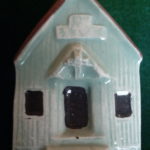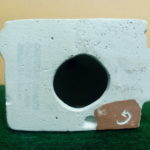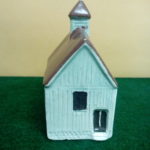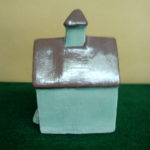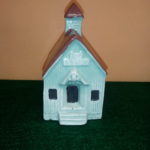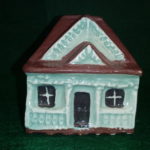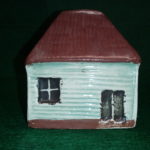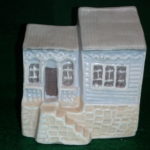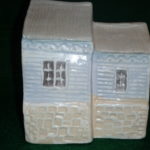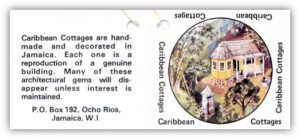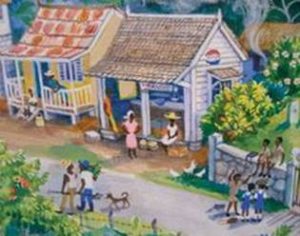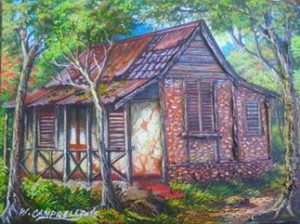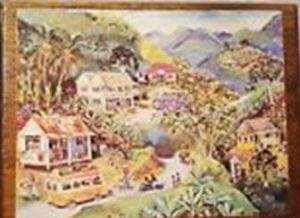This page is under construction/research.
I look forward to posting information and photos as and when I have the relevant information.
In the meantime I shall post some photos that I have of some models.
Below are a few photos of the model with the bell tower from my friend Eugene, a collector in the U.S.
This model, I believe, is a “rebirth” of the Sagebrush Junction schoolhouse, it makes sense as many designs for buildings spread around the world, and this seem to be an iconic design for a schoolhouse or even maybe a chapel.
Below are two more models from Eugene , including one that I have not seen before. The base stamps read : CARIBBEAN CERAMICS P.O. Box 192 Ocho Rios Jamaica West Indies
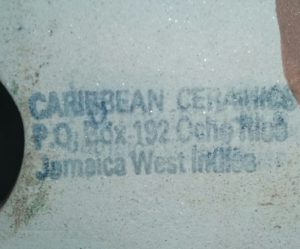 From the few photos here it is becoming apparent that there are several colours used in the finishing of these models, and they are of a very pleasant “pastel” hue.
From the few photos here it is becoming apparent that there are several colours used in the finishing of these models, and they are of a very pleasant “pastel” hue.
The following is an edited version of an email sent to me from Antony, an avid collector with whom I have had correspondence over the years. He has put some work into this project.
This tag accompanied a Caribbean Ceramics Jamaican House I found recently – these tags were attached to the cottages (or sometimes curled and stuffed inside) to explain the items. The other side of this folded tag is (sadly) blank – I suppose that’s where a price could have been written or tagged — but of course I was hoping it might have drawings of the various models…
The picture itself is a watercolour by Eve Foster, an English-Jamaican painter whose work captured a great deal of special Jamaican architecture and was the basis of at least some of the Caribbean Ceramics cottage models.
The Models
As mentioned on the tag, the Caribbean Ceramics pieces are models of specific actual buildings – though I haven’t been able to identify them all by lining up photos of the exact originals or locations. Plus of course, there was likely at least SOME artistic license in combining some of these types of buildings. It’s also not sure that 100% of the models are of Jamaican locations (even though it IS very clear now that Caribbean Ceramics was very much a Jamaican project). But there are certainly (from photos and Eve’s paintings) some obvious-looking matches:
Also of historical interest, some of these tiny cottages were originally from a specific class of “workers’ houses” or “labourers’ cottages” or “chattel houses” (specifically as called in Barbados) that are found throughout the Caribbean (which likely originated in the darker days of slavery).
Plantation owners bought these pre-fabricated wood kits by the dozens or hundreds, which came with standard-sized lumber pieces with cleverly cut notches so that the entire house could be assembled without nails or other hardware. This was important since it enabled the houses to be quickly taken apart, moved and reassembled elsewhere where the workers were necessary. And as such, there weren’t real foundations either – they were simply set on blocks.
Another give-away is the right-and-left symmetry — like the door in the middle with identical windows on each side, which reduced the number of different timber components, further simplifying assembly. Some of the Caribbean Ceramics models show this symmetry very clearly.
Eventually as times changed, many of these houses became permanently located, and all manner of additions and changes were made. For example, the cottage on the tag above is just one of the plain “one-roof” houses with an octagonal cupola added on one end.
For the last few decades, there has been growing interest in preservation and protecting this iconic Island legacy, since so many have been abandoned and left to the mercy of the elements.
Caribbean Ceramics.
This part of the story is about Annabella and Peter Proudlock. Annabella (then Ogden) was a model, but widowed with two children and moved to Jamaica in 1966. She was fascinated by the local art, and with her new husband Peter, bought a large ramshackle building (a “mid-19th century Methodist manse”) in the early ‘80s and restored it to create ‘Harmony Hall’ , a great success and mecca for Jamaican artists and craftsmen to work as well as sell their products – such as Eve Foster. Although both Peter and Annabella have passed in the last few years, Harmony Hall remains a crucial fixture in the Jamaican world of art as one of its largest outlets, with more than 100 artists, and especially involving preservation of Island hand-craft and artistic traditions.
It seems that it was Peter Proudlock who was mostly responsible for Caribbean Cottages. He converted a cottage on their property to set up a small pottery studio, where the Caribbean Cottages were made. These cottages were then sold at Harmony Hall, and were also distributed and sold across Jamaica and the Caribbean. It seems that Caribbean Ceramics may have continued production up to as recently as 2002, when the studio was reconverted and became “Seaside Cottage” (with stairs down to the water and sand in the back…).
So — what does all this have to do with Mudlen End?
I had a rare lucky break, and was able to locate a very nice man in Jamaica by the name of Sebastian Ogden – he is Annabella’s son and still very much involved in Harmony Hall.
He was very kind to tell me – as we might have guessed – that James Hart was also in the very center of all this. It’s not clear whether Mr. Hart chanced upon Harmony Hall and met Peter while exploring during a Jamaica holiday, or if Peter or Annabella Proudlock saw or remembered Mudlen End from the UK, but Peter and James worked together to create Caribbean Ceramics.
That sure makes perfect sense to me – it may be my own speculation, but from what we can all see in the cottages, James Hart had a special attraction to quintessential local architecture, houses and their designs – obviously the many unique Suffolk archtypes (which were so often named for their type) but then also those unusual Alsace, Brittany, Flanders and Danish structures that appear nowhere else, and the Old West “Americana” from Sagebrush. So why would he not have been captivated by these tiny, nowhere-else Jamaican structures in those remarkable color combinations — and working together with interesting like-minded people with a passion for preservation and handicraft?
Sebastian told me that James Hart designed at least six – and there may have been twelve – of these cottages. Those set numbers make sense too, fitting what we’ve seen before from Mr. Hart, given the one (or two) sets of six Sagebrush Junction models, and the French/Danish models, also apparently developed as a “six” together, and the six boxed English Country Cottages sets. Oh – and then the Lark Rise set of six of course.
The highest “number” I have seen so far is “G” (for the schoolhouse/chapel) so that would tell us that at least seven different models were made at one time or another. I’ve also now seen A, B, C and D, and guessing therefore that this one below will have either E or F on the bottom. Some others may have joined or left production based on popularity or new introductions.
Sebastian also mentioned that James Hart went over to Jamaica several times and stayed with Peter and Annabella, at first to talk and develop the idea, then working together with Peter to convert the cottage to the Caribbean Ceramics pottery, then again at least once or twice to train a small group of artisans to mold, fire and decorate the cottages in the studio they’d built.
And Sebastian remembers that he and his family even journeyed to Suffolk to visit Mudlen End.
“A lovely place…” he told me.
